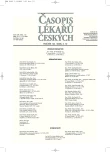Renal Angiomyolipoma, Histology, Diagnostics and Therapy
Renální angiomyolipom, histologie, diagnostika a terapie
Východisko.
Renální angiomyolipom je benigní mezenchymový nádor s incidencí 0,3–3 % chirurgicky explorovaných nádorů ledvin. Nádor se často vyskytuje ve spojení s tuberózní sklerózou. Nádor má natolik patognomický obraz na CT, že lze podle něj stanovit diagnózu. Symptomatologie a komplikace jsou závislé na velikosti nádoru. U velkých či symptomatických nádorů je indikována resekce nádoru, nefrektomie či ablace in situ.
Metody a výsledky.
Na Urologické klinice FN Plzeň bylo v letech 1996–2004 operováno 612 pacientů s nádorem ledviny. Angiomyolipom byl u 7 pacientů. Průměrný věk v době operace byl 64 let, poměr žen a mužů 5 : 2. U 3 pacientů byla přítomna klinická symptomatologie. Nádory byly 2–8 cm velké, u pěti pacientů solitární. Translumbální resekce nádoru byla provedena u tří pacientů. Translumbální nefrektomie byla provedena dvakrát pro suspekci z malignity. Tyto tumory byly zároveň vícečetné. V jednom případě bylo vysloveno podezření na tuberózní sklerózu. Ve dvou případech byl angiomyolipom náhodným nálezem při nefrektomii indikované pro jinou diagnózu.
Závěry.
U většiny nemocných stanovíme diagnózu podle zobrazení angiomyolipomu na CT. U některých jeho variant není zobrazení tak typické, a proto volíme operační revizi.
Klíčová slova:
benigní nádory ledvin, renální angiomyolipom, nefrektomie, resekce, ablace.
Authors:
T. Ürge; M. Hora; O. Hes 1; Z. Chudáček 2
Authors‘ workplace:
Urologická klinika LF UK a FN, Plzeň
; Šiklův patologicko – anatomický ústav LF U, Plzeň
1; Radiodiagnostická klinika LF UK a FN, Plzeň – Bory
2
Published in:
Čas. Lék. čes. 2005; 144: 821-823
Category:
Original Article
Overview
Background.
Renal angiomyolipoma is a benign mezenchymal tumour with prevalence of 0,3–3 % of all surgically resected renal tumours. Tumour is often associated with tuberous sclerosis complex or with another fakomatosis. Tumour has typical pathological image in computer tomography notation that enables the diagnosis. Symptomatology and possible complications depend on the tumour size. Large or symptomatic tumours are indicated for resection, nephrectomy or local ablation.
Methods and Results.
612 patients with renal tumour were operated at the Department of Urology faculty hospital in Pilsen. Angiomyolipoma occurred in 7 patients. Average age at the time of operation was 64 years, ratio female and male was 5 : 2. Clinical symptomatology was expressed in 3 patients. The size of tumour was 2 to 8 cm, in 5 patient the tumors were solitary. Translumbal tumour resection was performed in 3 patients. These tumours were at the same time multifocal. Suspicion from tuberous sclerosis was pronounced in some care. The angiomyolipoma was accidentally found in 2 cases of nephrectomy, which was indicated for other diagnosis.
Conclusions.
We define diagnosis by means of CT notation in the most of patients. This notation is not typical by any version of angiomyolipoma and we choose therefore surgical revision.
Key words:
benign renal tumours, renal angiomyolipoma, nephrectomy, resection, ablation.
Labels
Addictology Allergology and clinical immunology Angiology Audiology Clinical biochemistry Dermatology & STDs Paediatric gastroenterology Paediatric surgery Paediatric cardiology Paediatric neurology Paediatric ENT Paediatric psychiatry Paediatric rheumatology Diabetology Pharmacy Vascular surgery Pain management Dental HygienistArticle was published in
Journal of Czech Physicians

- Metamizole vs. Tramadol in Postoperative Analgesia
- Metamizole at a Glance and in Practice – Effective Non-Opioid Analgesic for All Ages
- Metamizole in perioperative treatment in children under 14 years – results of a questionnaire survey from practice
- Obstacle Called Vasospasm: Which Solution Is Most Effective in Microsurgery and How to Pharmacologically Assist It?
- Possibilities of Using Metamizole in the Treatment of Acute Primary Headaches
Most read in this issue
- Renal Angiomyolipoma, Histology, Diagnostics and Therapy
- Mosaicplasty in the Treatment of Knee Injuries
- Cognitive Dysfunction and Its Therapy
- Innate Immunity, Receptors for Exogenous and Endogenous Danger Patterns in Immunopathogenesis of Atherosclerosis – Part I: Identification of Danger Signals by Innate Immunity
